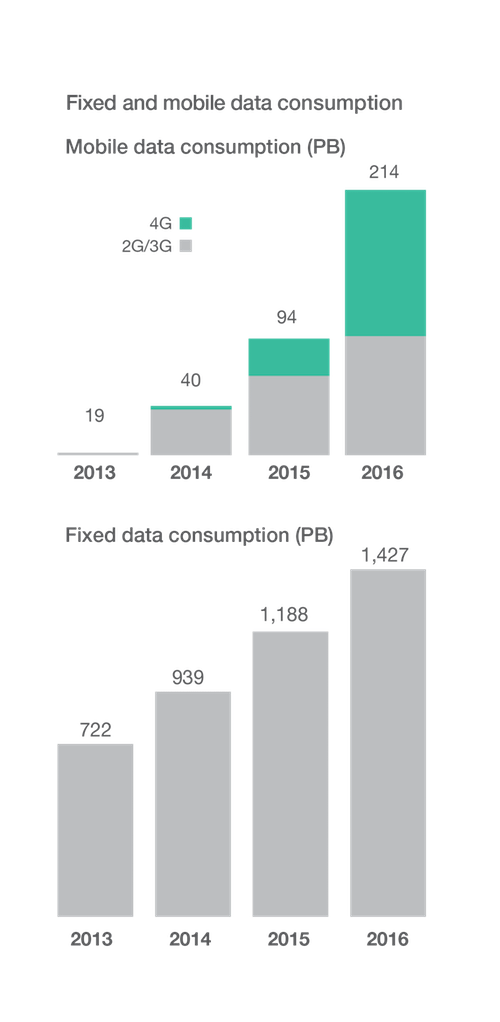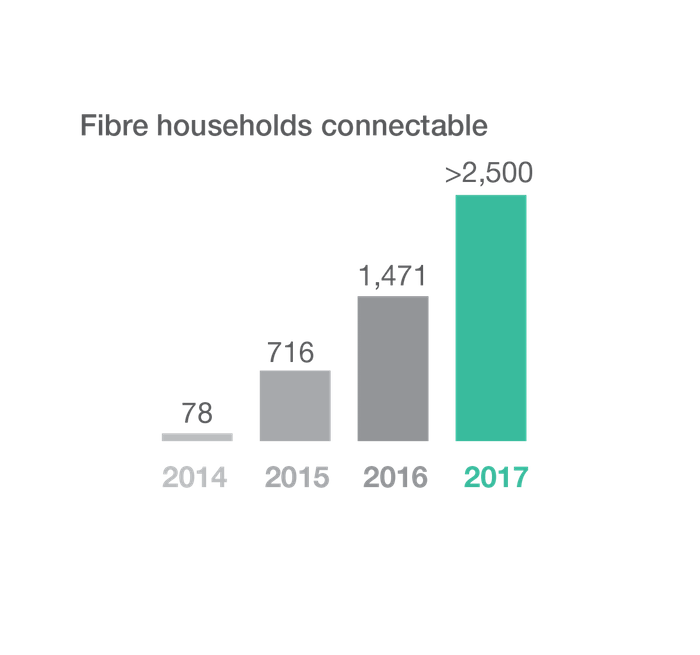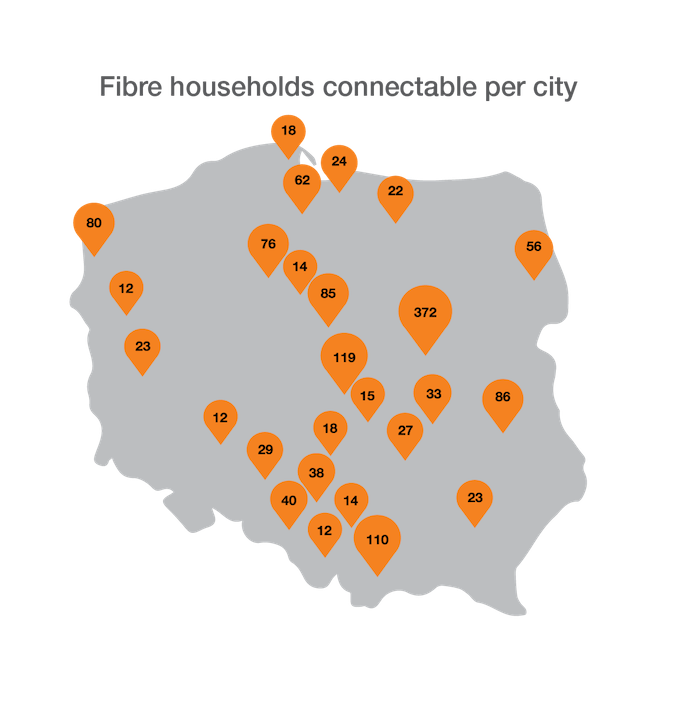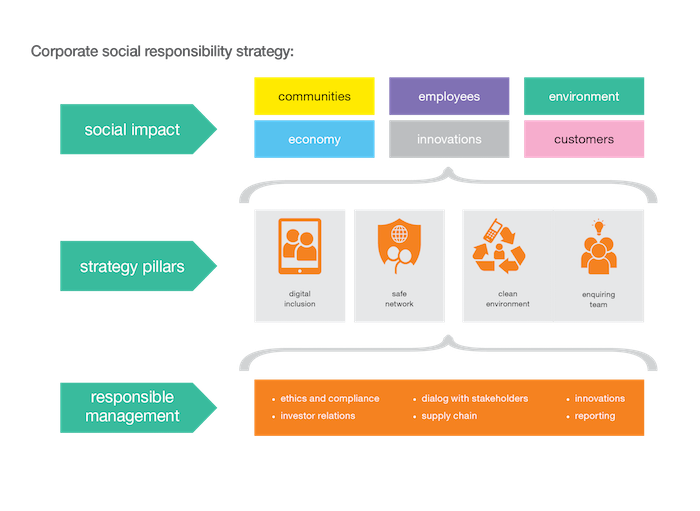|
|
It’s all about data
While voice and messaging continue to be very
important for our business, it is quality of data connectivity that has become the key criterion in selecting
a telecom service provider. This is because as the
world is becoming more and more digital, customer
needs are evolving and the number of smartphones
and other connected devices is rapidly rising. As a
consequence mobile but also fixed data consumption continues to grow very fast and that trend is
expected to continue in the years ahead.

|
|
|
Convergent network
Customers want fast, reliable and safe broadband
access, and from their point of view the technology
by which the service is delivered is less important. It is
our strongly-held opinion that fulfilling customer needs
requires both first class mobile and fixed connectivity.
Mobile only will not be sufficient. Fast fixed broadband is necessary to digest future demand for data
driven by heavier and heavier traffic and demand for
streaming, and at the same time to provide a desirable
customer experience on mobile network. In addition,
a substantial part of our operations is dedicated to
business customers who specifically cannot rely only
on mobile technology.
|
|
|
Local approach
Our connectivity strategy takes careful account of
differences in local markets. Polish households are
split roughly equally between big cities, small cities and
rural areas. Each of these zones is different, mainly with
respect to the competitive environment, our market
shares in particular segments and connectivity options.
In big cities our connectivity strategy will be concentrated around fixed, where our market shares have
eroded in the past years and where our approach has
to be offensive. In rural areas, the main connectivity
option is mobile technology. Fixed technologies will
be developed more opportunistically. A good example
will be the deployment of fibre technology using EU
subsidies in the government POPC programme. In
small cities, the situation is much less homogenous,
and connectivity development is based on the mix of
fixed and mobile.
|
|
|
Fixed – from legacy to future-proof fibre
The majority of our fixed broadband network is based
on ADSL technology, which does not provide a desirable customer experience and therefore is not competitive. For the past few years we have been developing
VDSL technology, but this alone is not sufficient to
close the technology gap to cable companies, our key
competitors in the fixed broadband market. To change
that in 2015 we made a strategic decision to invest on
a large scale in the deployment of a fibre to the home
(FTTH) network, which will structurally improve our
competitive position and give us the leverage to win
back market share in densely populated areas. This
investment is concentrated largely in big cities but also more selectively in medium and small cities.
In 2015-2016 we invested around PLN 850 million
is fibre network deployment, covering almost 1.5
million households in 37 cities. This already makes
ours the largest fibre network in Poland.
In 2017 we plan to accelerate and cover more than
1 million new households. Total capex for 2017
is envisaged at around PLN 800 million. We will
most likely maintain this fast pace of fibre network
deployment for some time beyond 2017. Exact
plans are being updated at the moment and will be
presented later in the year. The rollout will be very
closely monitored with respect to the monetisation
i.e. number of customers and value they bring.
This depends mainly on level of competition and
our sales effectiveness. Investment in fibre is by
its nature long term, but in our view this is future
proof technology, the parameters of which may be
easily upgraded in the future if needed.

|
|
|
Mobile – fast deployment following spectrum auction
Our strategic position in the mobile market improved
significantly following the 800MHz and 2600MHz
spectrum auction that finished in October 2015.
Although very expensive, purchase of two blocks
of 800MHz was absolutely necessary for us to be
able to offer a competitive service and compete in
rural areas. By the end of 2016 our 4G/LTE mobile
network reached almost the entire Polish population
on an outdoor basis and 87% on indoor. From 2017
we will further invest in the area coverage, mainly
on 800MHz; selectively densify the network; and
strengthen network capacity, investing in 2600MHz
to proliferate more spectrum aggregation and increase speed to customers. According to independent source speedtest.pl, our mobile network was
the fastest in Poland in 2016.
|
|
|
Convergence – our key market differentiator
In the section above we described how our
connectivity strategy will adapt to the specifics
of local markets. Our commercial approach also
takes this into consideration; however, there is
a common denominator in all the zones, which
is service convergence. Convergence we define
as delivering a package of both mobile and
fixed services.
Convergence gives us the following key benefits:
-
It constitutes our competitive edge, a key
market differentiator that we intend to take
even more advantage of in the future. On one
hand cable operators do not offer mobile services on any meaningful scale. On the other
hand our mobile competitors do not invest in
fixed access networks. We use this advantage not only in the consumer market but
also in the case of small business customers.
-
It is a good customer loyalty tool. Convergent customers tend to churn a lot less than non-convergent customers.
-
It allows us to win a higher share of household media and telecom budgets.
Convergence appears to have been a very effective
tool for customer acquisition when it comes to
fibre technology. By the end of 2016 more than
50% of our fibre customers were also using our
mobile services in convergent packages.

|
|
|
TV content – an important success factor
An important factor in the success of our convergent strategy is the quality of TV content, which
is very important for Polish consumers when
choosing a service provider. In 2016 we changed
the way we source our TV conten t both on IPTV
and satellite technology. It allowed us to be more
flexible in the way we shape our offer and price it.
In 2017 we became the first operator in Poland
to launch a decoder that allows customers to
watch 4K Ultra HD TV. We intend to remain a
content reseller: our strategy does not foresee
any significant investments in exclusive content.
|
|
|
Orange Love – a new convergent formula
We have pursued a convergent strategy for
few years now. However at the start of 2017
we changed the formula. The previous formula,
which we called Orange Open, we based on a
pick-and-mix concept. Customers could get a
discount on the price of any additional service
purchased from us. With market development
this concept largely lost its competitive edge.
In February 2017 we replaced it with the Orange Love offer: a predefined set of fixed and
mobile services bundled together and sold at
an attractive fixed price. The basic package
can be extended with extra fees for additional
SIM cards, higher fibre broadband speed and
additional TV content. Importantly, Orange
Love is available on any broadband technology
(fibre and copper) and also on LTE positioned
as home broadband.
|
|
|
Improving customer experience – towards a more friendly approach
Our strategic goal is to become the most frequently
recommended telecom operator in Poland by 2020.
We want to provide an effortless and friendly customer experience along the entire customer journey,
for every point of contact, every customer interaction
(with the quality of network, product, website, service, content, employee, message, call centre).
Building trust and loyalty among our customers and
giving them what they want is vital to our sustainability in an increasingly competitive industry. Differentiating our service and products is key as we
want our customers to recommend us to others.
More access to mobile services and better network
quality, more value for money and simpler pricing structures, more convenient interactions: all of
these add up to better customer experience.
We listen to our customers to identify and eliminate
the reasons for their dissatisfaction. We simplify our
portfolios and processes. We get customers actively involved in a dialogue with us through:
-
studies comparing our portfolio, products and connectivity vs. our competition;
-
post-contact satisfaction surveys;
-
managers’ commitment to ‘In the Front Line’ initiative;
-
debates with the Management Board Members aimed to better understand the customer perspective.
Customer Experience issues are discussed
on an ongoing basis. At Orange Polska we
have a dedicated Customer Experience
Committee within our Management Board
and Executive Directors which is devoted
to Customer Experience improvement. This
committee meets on a monthly basis to reinforce the focus on customers. Key directors
(reporting directly to Management Board or
Executive Directors) meet on a weekly basis.
Our Management Board includes a member
responsible for Customer Care and Customer
Excellence.
|
|
|
Approach driven by customer journeys
Our goal is to make all customer journeys as
simple as possible by eliminating unnecessary pain-points and procedures – a goal that
depends not only on big initiatives but mostly on the implementation of numerous small
actions. Over the past two years we made
big progress in improving our net promoter
score (NPS). At the end of 2016 it reached
an all-time high as a result of significant improvements in satisfaction among our mobile
customers, on both B2C and B2B markets.
We want to make further gains in this direction in 2017. Right now, we are making big
changes in the way we manage the customer experience. Our approach going forward
will be driven by customer journeys (different
types of experience, such as purchase, payment, termination or help) instead of distribution channels. This will allow us to provide a
standardised and coherent quality of service
across all customer touchpoints.
|
|
|
In Orange Polska, we have been successfully implementing a policy of corporate business responsibility
in all areas of our business for several years now. Our
CSR strategy accounts for the company’s business
objectives and fits into their implementation.
The conclusions from a dialogue with stakeholders
as well as market trends and social challenges for
our industry in Poland and abroad have been key
elements in its development.
For us, social responsibility means an organisational
culture which takes account of the expectations of
employees and other stakeholder groups – customers, investors, suppliers, business and social
partners as well as the environment – in creating
and implementing our business strategy.
We believe that such an approach generates benefits for the company and its environment, leads
to long-term development and contributes to the
improvement of everyone’s lives. Therefore, in
Orange Polska we have created a social responsibility
strategy which focuses on five areas which are of
key importance from the point of view of our sector
and our operations on the Polish market. In 2016
we launched the new CSR strategy for 2016-2020
A strong foundation of this strategy is responsible
management – our values, ethics and compliance
and our dialogue with stakeholders as a tool for
understanding their expectations.
On this foundation are based four pillars of our
CSR strategy:
-
Digital inclusion- for everyone, regardless of their skills, residence, age or ability, to be able to make use of the opportunities offered by the digital world
-
Safe network- for the use of the latest technologies to be easy and risk-free
-
Clean environment - to pursue our business objectives with respect for ecological principles and in harmony with the environment
-
Enquiring team - to create a culture of co-operation, in which all employees feel respected and can freely pursue their professional goals and life passions.
Responsible management and actions within
these four pillars account for our social impact,
which is analysed in 6 areas: economy, innovations, customers, environment, communities
and employees.
Corporate social responsibility strategy:

|
|
|
Facing very high competition, ongoing pressure on our top line and the still significant
burden of our legacy, our strategy puts a lot of
emphasis on improving our efficiency on the
cost and capital expenditures side. We aim to
become a simpler and more focused company. The measures we take to achieve this are
both short term and long term.
Every year we undertake numerous actions to
save operating costs in all parts of our business. For a number of years we have been
delivering PLN 200-300 million of sustainable
costs savings per annum and our aim is to
continue this in the years ahead. The most
important source of the savings is labour. We
optimise employment on a continuous basis.
Over the past three years we reduced our
headcount by around 20%. The scale of reductions is always negotiated with our social
partners (there are 17 trade unions at Orange
Polska). The social plan currently in effect
covers the years 2016-2017. Based on this
plan we released around 1000 employees in
2016 and a roughly similar number is expected to leave in 2017. We see room for further
employment optimisations and we plan to negotiate new social plans. Apart from labour,
we optimise spending on IT services, network
maintenance, property expenses, promotion
and marketing and general expenses.
As a part of the strategic review that is currently ongoing we are analysing new initiatives that are expected to boost our efficiency
and make us a more efficient organisation.
These initiatives will focus on better reallocation of resources to growth pillars and priority
areas on one hand. On the other hand, they
will prioritise the simplification of internal processes including, among others, a reduction
in the number of processes and their variants,
automation, digitisation and more agile IT.
|












